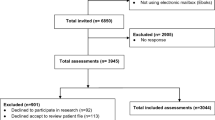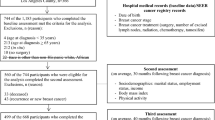Abstract
Purpose
Musculoskeletal events (MEs) resulting from breast cancer treatment can significantly interfere with the quality of life (QOL) of older adults. We evaluated the incidence of MEs in women 65 years and older who had surgery and adjuvant chemotherapy for breast cancer, and the impact of treatment on MEs and arm function.
Patients and methods
Patient-reported data in Alliance/CALGB 49907 were collected using the EORTC QLQ-BR23 and physician-reported adverse events to characterize self-reported MEs and incidence of lymphedema. EORTC QLQ-BR23 items related to musculoskeletal events were analyzed in this study and data collected at study entry (post-operative) and 12 and 24 months post-entry.
Results
Lymphedema, arm function, and ME data were available for 321 patients. One or more MEs were reported by 87% (median number = 3) and 64% (median number = 1) of patients post-operatively and at 24 months. At 24 months 2% had persistence of six MEs. Seventy-four percent experienced at least ≥3/6 types of MEs over the 24-month period. Detection of lymphedema at any time during the study was noted in 7.5% of the patients and appeared to be associated with the type of chemotherapy given: CMF 16.4%, capecitabine 5.8%, and AC 4%. Mastectomy and axillary node dissection were associated with the most MEs. LROM correlated with poorer arm function at all time periods.
Conclusion
Potentially debilitating MEs occur in three-fourths of elderly women undergoing standard therapy for breast cancer. Emphasis should be placed on prevention, identification, and treatment of these MEs to improve QOL.

Similar content being viewed by others
References
Shah C, Arthur D, Riutta J et al (2012) Breast-cancer related lymphedema: a review of procedure-specific incidence rates, clinical assessment AIDS, treatment paradigms, and risk reduction. Breast J 18:357–361
Ozcinar B, Guler SA, Kocaman N et al (2012) Breast cancer related lymphedema in patients with different loco-regional treatments. Breast 21:361–365
Kwan W, Jackson J, Weir LM et al (2002) Chronic arm morbidity after curative breast cancer treatment: prevalence and impact on quality of life. J Clin Oncol 20:4242–4248
Tasmuth T, von Smitten K, Kalso E (1996) Pain and other symptoms during the first year after radical and conservative surgery for breast cancer. Br J Cancer 74:2024–2031
Miaskowski C, Cooper B, Paul SM et al (2012) Identification of patient subgroups and risk factors for persistent breast pain following breast cancer surgery. J Pain 13:1172–1187
Karki A, Simonen R, Malkia E et al (2005) Impairments, activity limitations and participation restrictions 6 and 12 months after breast cancer operation. J Rehabil Med 37:180–188
Feiten S, Dunnebacke J, Heymanns J et al (2014) Breast cancer morbidity: questionnaire survey of patients on the long term effects of disease and adjuvant therapy. Dtsch Arztebl Int 111:537–544
Norman SA, Localio AR, Kallan MJ et al (2010) Risk factors for lymphedema after breast cancer treatment. Cancer Epidemiol Biomark Prev 19:2734–2746
Crew KD, Greenlee H, Capodice J et al (2007) Prevalence of joint symptoms in postmenopausal women taking aromatase inhibitors for early-stage breast cancer. J Clin Oncol 25:3877–3883
DiSipio T, Rye S, Newman B et al (2013) Incidence of unilateral arm lymphoedema after breast cancer: a systematic review and meta-analysis. Lancet Oncol 14:500–515
Muss HB, Berry DA, Cirrincione CT et al (2009) Adjuvant chemotherapy in older women with early-stage breast cancer. N Engl J Med 360:2055–2065
Kornblith AB, Lan L, Archer L et al (2011) Quality of life of older patients with early-stage breast cancer receiving adjuvant chemotherapy: a companion study to cancer and leukemia group B 49907. J Clin Oncol 29:1022–1028
Cancer Therapy Evaluation Program, Common Toxicity Criteria (CTC) Version 2.0, 1999
Mantel N (1963) Chi Square tests with one degree of freedom; extensions of the Mantel-Haenszel procedure. J Am Stat Assoc 58:690–700
Sakorafas GH, Peros G, Cataliotti L et al (2006) Lymphedema following axillary lymph node dissection for breast cancer. Surg Oncol 15:153–165
Kotronoulas G, Kearney N, Maguire R et al (2014) What is the value of the routine use of patient-reported outcome measures toward improvement of patient outcomes, processes of care, and health service outcomes in cancer care? A systematic review of controlled trials. J Clin Oncol 32:1480–1501
Pedro-Guzman J (2016) Managing Upper Extremity Dysfunction in Breast Cancer Survivors
Smoot B, Wong J, Cooper B et al (2010) Upper extremity impairments in women with or without lymphedema following breast cancer treatment. J Cancer Surviv 4:167–178
Lucci A, McCall LM, Beitsch PD et al (2007) Surgical complications associated with sentinel lymph node dissection (SLND) plus axillary lymph node dissection compared with SLND alone in the American College of Surgeons Oncology Group Trial Z0011. J Clin Oncol 25:3657–3663
Ashikaga T, Krag DN, Land SR et al (2010) Morbidity results from the NSABP B-32 trial comparing sentinel lymph node dissection versus axillary dissection. J Surg Oncol 102:111–118
Land SR, Kopec JA, Julian TB et al (2010) Patient-reported outcomes in sentinel node-negative adjuvant breast cancer patients receiving sentinel-node biopsy or axillary dissection: National Surgical Adjuvant Breast and Bowel Project phase III protocol B-32. J Clin Oncol 28:3929–3936
Gnant M, Thomssen C, Harbeck N (2015) St. Gallen/Vienna 2015: a brief summary of the consensus discussion. Breast Care (Basel) 10:124–130
Meretoja TJ, Leidenius MH, Tasmuth T et al (2014) Pain at 12 months after surgery for breast cancer. JAMA 311:90–92
Funding
Research reported in this publication was supported by the National Cancer Institute of the National Institutes of Health under the Award Number UG1CA189823 (Alliance for Clinical Trials in Oncology NCORP Grant), U10CA032291, U10CA047559, U10CA047577, U10CA077597, U10CA077651, U10CA180791, U10CA180838, U10CA180857, and U10CA180867. Supported, in part, by grants from the National Cancer Institute (U10CA031946 and U10CA033601), the National Institute on Aging (U10CA85850), the Breast Cancer Research Foundation, the Coalition of Cancer Cooperative Groups, and Roche Biomedical Laboratories. The content is solely the responsibility of the authors and does not necessarily represent the official views of the National Institutes of Health.
Author information
Authors and Affiliations
Corresponding author
Ethics declarations
Conflict of interest
The authors declare that they have no conflict of interest.
Rights and permissions
About this article
Cite this article
Hopkins, J.O., Allred, J., Hurria, A. et al. Lymphedema, musculoskeletal events and arm function in older patients receiving adjuvant chemotherapy for breast cancer (Alliance A171302). Breast Cancer Res Treat 166, 793–808 (2017). https://doi.org/10.1007/s10549-017-4454-7
Received:
Accepted:
Published:
Issue Date:
DOI: https://doi.org/10.1007/s10549-017-4454-7




